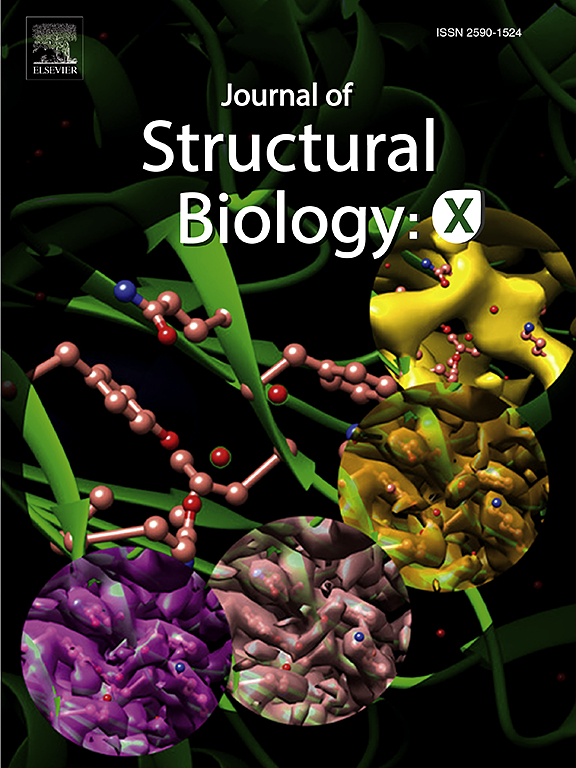对 SARS-CoV-2 核头壳 C 端结构的 RNA 结合抑制剂的结构研究。
IF 2.7
3区 生物学
Q3 BIOCHEMISTRY & MOLECULAR BIOLOGY
引用次数: 0
摘要
SARS-CoV-2核衣壳蛋白(N)是病毒粒子的基本结构元件,在将病毒基因组包裹成核糖核蛋白(RNP)组装体以及病毒复制和传播中起着至关重要的作用。n蛋白的c端结构域(N-CTD)对于包封至关重要,有助于RNP复合物的稳定。在之前的一项研究中,筛选了三种抑制剂(头孢曲松、头孢呋辛和氨苄西林),因为它们有可能通过靶向n蛋白破坏RNA包装过程。然而,结合效果、RNA结合抑制机制以及与N-CTD结合的分子机制尚不清楚。在这项研究中,我们评估这些抑制剂使用的绑定疗效等温滴定量热法(ITC),揭示了亲和力的头孢曲松钠(18 ±1.3 μM),头孢呋辛(55 ±4.2 μM),和氨苄青霉素(28 ±1.2 μM) N-CTD。进一步的抑制实验和荧光极化实验显示RNA结合抑制,抑制剂的IC50范围为 ~ 12 ~ 18 μM, KD值分别为24 μM ~ 32 μM。此外,我们还确定了N-CTD-头孢曲松(2.0 Å)和N-CTD-氨苄西林(2.2 Å)的抑制剂结合复合物晶体结构,以及载子N-CTD (1.4 Å)的结构。这些晶体结构揭示了先前未观察到的相互作用位点,包括寡聚化界面上的残基K261, K266, R293, Q294和W301以及N-CTD预测的rna结合区。这些发现为N-CTD的抑制提供了有价值的分子见解,突出了其作为开发新型冠状病毒抗病毒药物的潜力。本文章由计算机程序翻译,如有差异,请以英文原文为准。

Structural insights into the RNA binding inhibitors of the C-terminal domain of the SARS-CoV-2 nucleocapsid
The SARS-CoV-2 nucleocapsid (N) protein is an essential structural element of the virion, playing a crucial role in enclosing the viral genome into a ribonucleoprotein (RNP) assembly, as well as viral replication and transmission. The C-terminal domain of the N-protein (N-CTD) is essential for encapsidation, contributing to the stabilization of the RNP complex. In a previous study, three inhibitors (ceftriaxone, cefuroxime, and ampicillin) were screened for their potential to disrupt the RNA packaging process by targeting the N-protein. However, the binding efficacy, mechanism of RNA binding inhibition, and molecular insights of binding with N-CTD remain unclear. In this study, we evaluated the binding efficacy of these inhibitors using isothermal titration calorimetry (ITC), revealing the affinity of ceftriaxone (18 ± 1.3 μM), cefuroxime (55 ± 4.2 μM), and ampicillin (28 ± 1.2 μM) with the N-CTD. Further inhibition assay and fluorescence polarisation assay demonstrated RNA binding inhibition, with IC50 ranging from ∼ 12 to 18 μM and KD values between 24 μM to 32 μM for the inhibitors, respectively. Additionally, we also determined the inhibitor-bound complex crystal structures of N-CTD-Ceftriaxone (2.0 Å) and N-CTD-Ampicillin (2.2 Å), along with the structure of apo N-CTD (1.4 Å). These crystal structures revealed previously unobserved interaction sites involving residues K261, K266, R293, Q294, and W301 at the oligomerization interface and the predicted RNA-binding region of N-CTD. These findings provide valuable molecular insights into the inhibition of N-CTD, highlighting its potential as an underexplored but promising target for the development of novel antiviral agents against coronaviruses.
求助全文
通过发布文献求助,成功后即可免费获取论文全文。
去求助
来源期刊

Journal of structural biology
生物-生化与分子生物学
CiteScore
6.30
自引率
3.30%
发文量
88
审稿时长
65 days
期刊介绍:
Journal of Structural Biology (JSB) has an open access mirror journal, the Journal of Structural Biology: X (JSBX), sharing the same aims and scope, editorial team, submission system and rigorous peer review. Since both journals share the same editorial system, you may submit your manuscript via either journal homepage. You will be prompted during submission (and revision) to choose in which to publish your article. The editors and reviewers are not aware of the choice you made until the article has been published online. JSB and JSBX publish papers dealing with the structural analysis of living material at every level of organization by all methods that lead to an understanding of biological function in terms of molecular and supermolecular structure.
Techniques covered include:
• Light microscopy including confocal microscopy
• All types of electron microscopy
• X-ray diffraction
• Nuclear magnetic resonance
• Scanning force microscopy, scanning probe microscopy, and tunneling microscopy
• Digital image processing
• Computational insights into structure
 求助内容:
求助内容: 应助结果提醒方式:
应助结果提醒方式:


